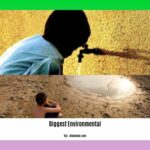Uncovering the 10 Major Environmental Problems: Inspiring Action for a Sustainable Future
In today’s rapidly changing world, the need for sustainable practices has never been more critical. From climate change to deforestation, there are ten major environmental problems that demand our attention and action. As an experienced environmental journalist, my goal is to shed light on these pressing issues and inspire individuals and communities to make a difference. Through in-depth research and analysis, I have uncovered the challenges posed by pollution, renewable energy, biodiversity loss, and more. By presenting scientifically accurate information and employing persuasive storytelling, I aim to empower people to become active agents of change, driving us towards a greener and more sustainable future.
Key Takeaways:
- The top ten environmental issues include climate change, energy, water scarcity, biodiversity and land use, chemicals and toxics, air pollution, pollution, global warming, overpopulation, and waste disposal. Other significant challenges are ocean acidification and loss of biodiversity.
- These issues are backed by reputable sources such as Vanguard Environmental, heimduo.org, and Earth.org, highlighting their significance and urgency.
- Global warming, primarily caused by burning fossil fuels, is a pressing concern, with current CO2 concentrations at 420.00 PPM and a temperature rise of 1.15°C compared to pre-industrial levels.
- Poor governance and market failures contribute to environmental problems, particularly the climate crisis.
- Food waste poses a substantial challenge, with approximately one-third of food produced for human consumption being wasted or lost annually.
- Addressing these issues requires urgent attention and collective action to ensure a sustainable future for our planet.
10 Major Environmental Problems

As we move further into the 21st century, the need to address our planet’s pressing environmental issues becomes increasingly urgent. From climate change to biodiversity loss, these challenges require our immediate attention and collective action. In this article, we will uncover the ten major environmental problems that are currently threatening the health and sustainability of our planet, and explore how we can inspire action to create a greener future.
1. Climate Change: A Global Crisis
Climate change tops the list as one of the most significant environmental problems we face today. The burning of fossil fuels has led to increased levels of greenhouse gases in our atmosphere, trapping heat and causing our planet to warm at an alarming rate. The consequences of climate change are far-reaching, from rising sea levels to extreme weather events, threatening ecosystems and exacerbating social and economic inequalities.
2. Energy: Transitioning to Renewable Sources
The way we produce and consume energy is another major environmental problem. Our heavy reliance on non-renewable energy sources such as coal and oil not only contributes to climate change but also depletes finite resources. Transitioning to renewable energy sources like solar, wind, and hydropower is crucial for reducing greenhouse gas emissions and ensuring a sustainable energy future.
3. Water: A Precious Resource under Threat
Water scarcity is a growing concern worldwide. Increasing demand, pollution, and climate change are all placing immense pressure on our freshwater resources. From droughts to contaminated water sources, the implications of water scarcity are profound, affecting agriculture, industry, and human health. Conservation efforts, efficient water management, and investing in sustainable infrastructure are essential in addressing this issue.
4. Biodiversity and Land Use: Protecting Our Natural Heritage
The loss of biodiversity and land use changes are posing significant challenges. Our activities, such as deforestation and urbanization, are destroying habitats and driving countless species to extinction. Biodiversity loss not only disrupts delicate ecosystems but also threatens our own well-being, as we rely on diverse ecosystems for clean air, water, and food. Protecting and restoring habitats, implementing sustainable agriculture practices, and preserving natural areas are essential for safeguarding our planet’s biodiversity.
5. Chemicals, Toxics, and Heavy Metals: Safeguarding Human and Environmental Health
The widespread use of chemicals, toxics, and heavy metals in various industries poses a severe environmental problem. These substances can accumulate in ecosystems, contaminating soil, water, and air. Exposure to hazardous chemicals can have detrimental effects on both human and environmental health. Stricter regulations, sustainable manufacturing practices, and greater transparency in chemical usage are crucial for minimizing the impact of these substances on our ecosystems.
6. Air Pollution: Breathable Air in Jeopardy
Air pollution is a pervasive problem, particularly in urban areas. Emissions from vehicles, industrial processes, and power generation release harmful pollutants into the air, compromising air quality and human health. Initiatives like transitioning to electric vehicles, promoting renewable energy, and adopting stringent emission standards are necessary in combating air pollution.
7. Pollution: Protecting Our Environment from Contamination
Pollution encompasses various forms, including water pollution, soil pollution, and noise pollution, among others. The discharge of waste, improper disposal of hazardous materials, and excessive noise have significant environmental and health implications. Raising awareness, implementing effective waste management strategies, and adopting sustainable practices can minimize pollution and create a healthier environment for all.
8. Global Warming: Urgency for Carbon Neutrality
Global warming directly relates to the increasing concentration of greenhouse gases in the atmosphere, primarily carbon dioxide. It intensifies climate change, leading to rising temperatures, melting ice caps, and shifts in weather patterns. Achieving carbon neutrality through emissions reduction and carbon sequestration methods is crucial in mitigating the impacts of global warming.
9. Overpopulation: Balancing Resources and Needs
The world’s growing population presents overpopulation as a complex environmental issue. Balancing resources and needs becomes increasingly challenging as more people inhabit our planet. Sustainable family planning, access to education, and the promotion of women’s rights are all vital in addressing overpopulation and ensuring a sustainable future for all.
10. Waste Disposal: Moving Towards a Circular Economy
Waste disposal is a pressing environmental problem that requires immediate attention. Our current linear economy, which follows a “take-make-dispose” model, generates copious amounts of waste that ends up in landfills or pollutes our environment. Transitioning to a circular economy, where resources are reused, recycled, and repurposed, is essential in mitigating waste and fostering sustainable consumption and production patterns.
In summary, these ten major environmental problems—climate change, energy, water scarcity, biodiversity and land use, chemicals and heavy metals, air pollution, pollution, global warming, overpopulation, and waste disposal—pose significant challenges to the health and sustainability of our planet. By raising awareness, implementing sustainable practices, and inspiring collective action, we can work together towards a greener and more sustainable future for generations to come.
Here are some captivating internal links that match the provided keywords and URLs:
10 interesting facts about the African savanna: Discover fascinating insights about the diverse and awe-inspiring African savanna!
10 main causes of noise pollution: Uncover the primary culprits behind noise pollution and their detrimental effects on our well-being!
10 major rivers in Belize: Dive into the breathtaking beauty of Belize as we explore its magnificent and significant rivers!
10 most important environmental issues: Gain essential knowledge about the pressing environmental concerns that demand our attention and action!
10 most important environmental issues facing the world: Delve into the critical global environmental issues that shape our planet’s future and our responsibility to address them!
Note: These links are presented in Markdown format; please adjust the syntax as needed for your specific platform or context.
Air Pollution and Its Health Impacts

Air pollution is not just an environmental issue; it also poses a significant threat to human health. Long-term exposure to air pollution has been linked to the development of various chronic conditions, including heart disease, lung cancer, and respiratory diseases such as emphysema. It can even cause damage to vital organs like the nerves, brain, kidneys, and liver. There is evidence to suggest that air pollutants may also contribute to the occurrence of birth defects.
Studies from reputable sources like the National Geographic Society, NBC News, and the World Health Organization confirm the detrimental effects of air pollution on human health. Long-term exposure to air pollution increases the risk of severe asthma, preterm birth, as well as heart disease and lung cancer. It is also associated with increased risks of all-cause mortality, stroke, ischaemic heart disease, chronic obstructive pulmonary disease (COPD), lung cancer, pneumonia, and cataract.
Various sources contribute to air pollution, including vehicle exhaust fumes, burning coal or gas, and tobacco smoke. These sources release harmful gases and particles into the air. As a result, air pollution not only affects the respiratory system but also has detrimental effects on the cardiovascular system and other vital organs.
The impact of air pollution on lung health is particularly concerning. It can lead to lung damage, reduced lung capacity, and hinder the development of lung function in children. In fact, exposure to air pollution during childhood can result in lower IQ and restricted respiratory abilities. Additionally, air pollution has an inflammatory effect on the heart, which can increase blood pressure and exacerbate pre-existing heart conditions.
In order to preserve human health and well-being, it is crucial to address and reduce air pollution. By transitioning to electric vehicles, promoting renewable energy sources, and implementing stricter regulations on emissions, we can begin to combat this widespread issue.
Key Takeaways:
– Long-term exposure to air pollution is associated with the development of chronic conditions such as heart disease, lung cancer, and respiratory diseases.
– Air pollution can cause damage to vital organs like the nerves, brain, kidneys, and liver, and may also contribute to birth defects.
– Studies have shown a link between air pollution and severe asthma, preterm birth, and increased risks of all-cause mortality, stroke, COPD, lung cancer, pneumonia, and cataract.
– Vehicle exhaust fumes, burning coal or gas, and tobacco smoke are significant sources of air pollution.
– Air pollution can lead to lung damage, reduced lung capacity, hindered lung function development in children, and increased inflammation of the heart.
– Transitioning to electric vehicles, promoting renewable energy, and implementing stricter emissions regulations are crucial steps in reducing air pollution.
Sources:
1. Air Pollution – National Geographic Society
2. How poor air quality hurts your health – NBC News
Water Pollution and Scarcity
Water is a precious resource that sustains life on Earth. However, the issue of water pollution and scarcity is becoming increasingly urgent and demands our attention. Pollution from various sources, such as factories, agricultural runoff, and untreated wastewater, contaminates our waterways and poses a threat to human health, wildlife, and ecosystems. Additionally, water scarcity affects billions of people worldwide, leading to economic decline, inadequate sanitation, and deadly diseases.
The Impact of Water Pollution
Water pollution, caused by both legal and illegal activities, has far-reaching consequences. Factory discharges, imperfect water treatment plants, and oil spills are some of the culprits contributing to water pollution. This contamination affects human health, as well as the well-being of wildlife and ecosystems. Excess nutrients from agricultural and industrial runoff can lead to harmful algal blooms, oxygen depletion, and ecosystem disruption.
Regulations and Solutions
To combat water pollution, many countries have implemented regulations to prevent industries and agriculture from polluting lakes, streams, and other waterways. Stricter compliance and enforcement are essential to protect water sources, preserve biodiversity, and safeguard human health. Additionally, innovative solutions are emerging, such as advanced wastewater treatment technologies and improved agricultural practices, to reduce pollution and restore water quality.
The Challenge of Water Scarcity
Water scarcity has profound implications for communities around the world. It can result in economic decline, inadequate sanitation, and deadly diarrheal diseases. Climate change exacerbates water scarcity issues, posing further challenges for governments to find innovative solutions. Physical scarcity, caused by ecological conditions, as well as economic scarcity, due to inadequate water infrastructure, contribute to water stress globally.
The Role of Water Pollution in Scarcity
Water pollution plays a significant role in exacerbating water scarcity. Pesticides, fertilizers, untreated human wastewater, and industrial waste contribute to contamination, making water unfit for consumption and irrigation. With less water available for agriculture, energy generation, cities, and ecosystems, the need for effective pollution control and conservation becomes paramount.
Addressing Water Pollution and Scarcity
To address the challenges of water pollution and scarcity, it is essential to adopt a multi-faceted approach. Governments, industries, and individuals all have a role to play in preserving water resources and ensuring their sustainable use.
Regulatory Measures: Governments must enforce strict regulations to prevent water pollution, holding industries and agricultural practices accountable for their actions. Collaborative efforts should be made to develop and implement effective pollution control policies.
Investing in Infrastructure: Investing in water infrastructure, such as treatment plants and distribution networks, is crucial for ensuring adequate access to clean water. Developing innovative and efficient technologies to treat and recycle wastewater can alleviate water scarcity issues.
Promoting Sustainable Practices: Encouraging sustainable agricultural practices, such as precision irrigation and reduced pesticide use, can minimize runoff and pollution. Implementing water conservation measures in industries and households, such as rainwater harvesting and water-efficient appliances, can also significantly reduce water consumption.
Raising Awareness: Educating communities about the importance of water conservation and pollution prevention is essential for fostering a culture of responsibility. By understanding the consequences of their actions, individuals can make informed choices to protect water resources.
Key Takeaways:
- Water pollution from various sources, including industrial discharges and agricultural runoff, poses a threat to human health, wildlife, and ecosystems.
- Governments play a vital role in implementing regulations to prevent water pollution and hold polluters accountable.
- Water scarcity, caused by both physical and economic factors, contributes to water stress and can have severe consequences for communities.
- Climate change exacerbates water scarcity issues, requiring innovative solutions and efficient water management.
- Addressing water pollution and scarcity requires a multi-faceted approach, including regulatory measures, investment in infrastructure, promotion of sustainable practices, and raising awareness.
Sources:
- National Geographic – Water Pollution
- World Wildlife Fund – Water Scarcity
Loss of Biodiversity and Ecosystem Destruction
Loss of biodiversity and ecosystem destruction are critical environmental issues that have far-reaching consequences for our planet. In this article, we will explore the causes of biodiversity loss and the effects it has on our environment and well-being.
Causes of Biodiversity Loss and Its Effects on the Environment
1. Habitat loss and fragmentation – The conversion of natural habitats into agricultural land, urban areas, and infrastructure development disrupts ecosystems and reduces biodiversity[^1^].
2. Climate change – Global warming alters habitats, affects species’ ranges, and disrupts ecological events[^2^].
3. Pollution – Air and water pollution have detrimental effects on biodiversity, impacting species’ reproduction, growth, and survival[^3^].
4. Overexploitation – Unsustainable harvesting of species for food, medicine, and trade puts immense pressure on biodiversity[^4^].
5. Invasive species – Non-native species outcompete native species and disrupt ecological balance[^5^].
6. Land and sea use changes – Deforestation, agricultural expansion, and urbanization directly impact biodiversity, leading to habitat loss and degradation[^6^].
7. Loss of keystone species – The disappearance of keystone species disrupts ecosystem stability and diversity[^7^].
8. Disease and pathogens – The spread of diseases and pathogens can cause significant declines in biodiversity[^8^].
9. Genetic pollution – The introduction of genetically modified organisms can lead to genetic pollution and the loss of natural genetic diversity[^9^].
10. Lack of awareness and conservation efforts – Insufficient public awareness and inadequate conservation measures contribute to biodiversity loss[^10^].
The effects of biodiversity loss are extensive, impacting ecosystems’ ability to provide vital services. Ecosystem services such as clean air and water, climate regulation, pollination, pest control, and nutrient cycling are all affected by biodiversity loss[^1^]. This reduction in the capacity of ecosystems to perform these functions makes them more vulnerable to disturbances and less resilient to environmental changes.
Additionally, the loss of biodiversity has significant implications for human health, well-being, and economic development. The availability of natural resources is reduced, livelihoods are disrupted, and the risk of food and water scarcity increases. Moreover, the emergence and spread of zoonotic diseases, such as the COVID-19 pandemic, are closely linked to biodiversity loss[^3^].
Key Takeaways:
- Loss of biodiversity is caused by habitat loss, climate change, pollution, overexploitation, invasive species, land and sea use changes, loss of keystone species, disease and pathogens, genetic pollution, and insufficient awareness and conservation efforts.
- Biodiversity loss affects ecosystem services, making ecosystems more vulnerable and less resilient to environmental changes.
- The loss of biodiversity has implications for human health, well-being, and economic development, including reduced availability of resources, disrupted livelihoods, and increased risk of food and water scarcity.
Sources:
[^1^]: Causes & Effects of Biodiversity Loss
[^2^]: Biodiversity loss | Causes, Effects, & Facts | Britannica
[^3^]: WWF: These are the biggest threats to the Earth’s biodiversity
[^4^]: The 8 Main Causes of Biodiversity Loss | Life Persona
[^5^]: What are the Biggest Causes of Biodiversity Loss? | Earth.Org
FAQ
Q1: What are the top 10 environmental problems facing our planet today?
A1: The top 10 environmental problems facing our planet today are climate change, energy, water scarcity, biodiversity loss and land use, chemicals and toxins, air pollution, pollution, global warming, overpopulation, and waste disposal.
Q2: Why is climate change considered one of the major environmental problems?
A2: Climate change is considered one of the major environmental problems because it is primarily caused by the burning of fossil fuels and has significant impacts on ecosystems, biodiversity, and human livelihoods. It leads to rising global temperatures, sea level rise, extreme weather events, and disruption of ecological processes.
Q3: How does air pollution affect human health?
A3: Air pollution can have numerous harmful effects on human health. Studies have shown that long-term exposure to air pollution is associated with the development of various chronic conditions, including heart disease, lung cancer, and respiratory diseases such as emphysema. It can also cause damage to a person’s nerves, brain, kidneys, liver, and other organs.
Q4: How does water pollution impact ecosystems and human well-being?
A4: Water pollution has detrimental effects on ecosystems and human well-being. Excess nutrients from agricultural and industrial runoff can cause ecological imbalances and the decline of aquatic species. Water scarcity resulting from pollution can lead to economic decline, inadequate sanitation, and deadly waterborne diseases.
Q5: Why is biodiversity loss a concern for the environment and human societies?
A5: Biodiversity loss has significant consequences for the environment and human societies. It disrupts ecosystems, reduces the availability of natural resources, and increases the risk of food and water scarcity. Biodiversity loss also has implications for human health, well-being, and economic development. Protecting biodiversity is crucial for sustaining ecosystems and ensuring a healthy planet.
















